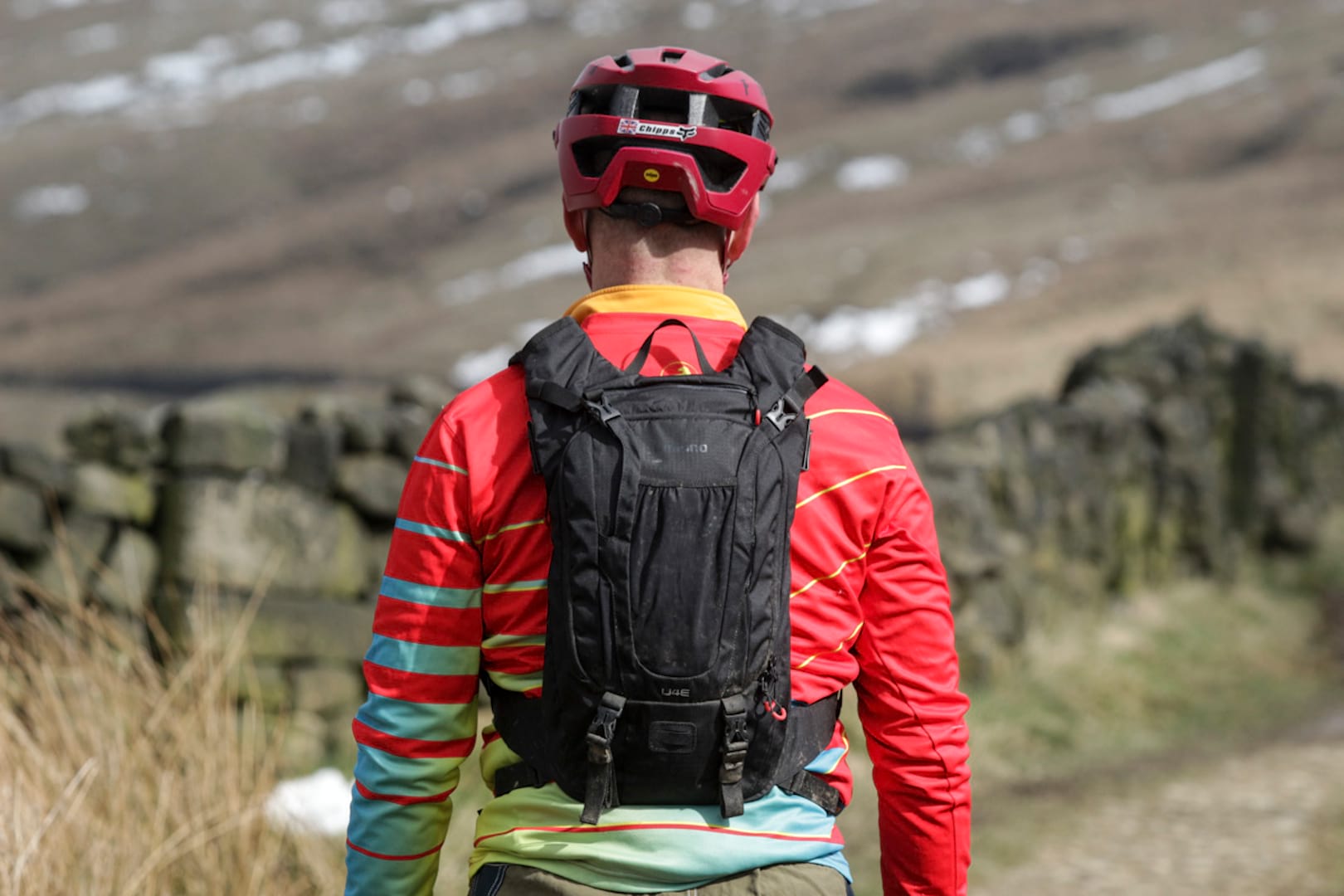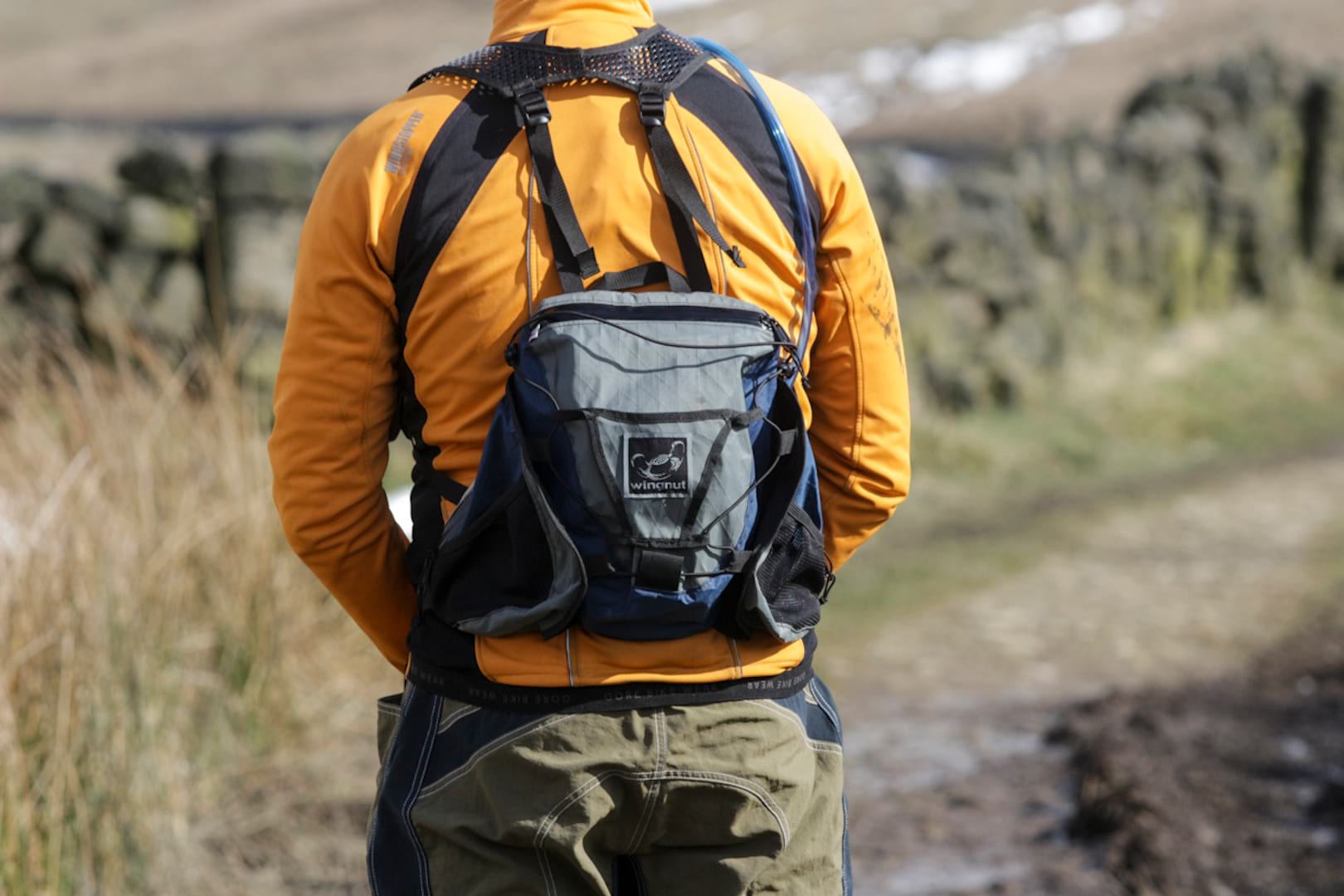Not everyone wants to ride with a big ‘n’ heavy backpack, so we’ve been testing a variety of different options for the minimalist mountain bikers out there, waist packs, frame bags and mini-packs.
Here, we have the micro-packs – basically, a backpack, only smaller. These strip down the classic riding rucksack to its bare essentials, often adding maximum ventilation and a very secure harness along the way to make something that, in theory, you can forget you’re wearing. The capacity of these packs varies dramatically – some are big enough for a day ride, and some are barely more than a bladder with a pocket on the front.
Winner – Wingnut Hyper 1.8
- Price: £69.99
- From: Rough Ride Guide

Wingnut Gear has been around for a over a decade, but it’s still a small manufacturer and you still don’t see many on the trail. The range includes packs in sizes up to 25L, that all share a similar design. Rather than putting the weight up between your shoulder blades, the packs feature longer straps that drop the load right down, so it sits over your lumbar region.
The idea isn’t exclusive to Wingnut, but it’s what it specialises in, and it also holds a patent on another feature of the design: the ‘wings’ that give the brand its name. The Hyper 1.8 is its smallest pack, and holds around five litres, so it’s one of the larger bags in this test, but it’s still firmly aimed at the short ride crowd.

All Wingnut bags are made in the US, and the Hyper 1.8 uses a quality sailcloth fabric that looks a lot like the bikepacking luggage fave VX21. This has a diamond ripstop pattern with a rubberised inner face, to make it wear and tear resistant and as waterproof as possible on a pack with stitched seams. The all-weather design of the pack is also apparent from the waterproof zips.
The Hyper features a separate reservoir pocket, behind a generous main pocket that’s quite capable of holding a bulky waterproof or a thermal layer. To the sides of this are the ‘wings’, each of which sports a sizeable zipped pocket, and a small cargo net which looks perfect for an inner tube, spare gloves or similar. Finally, the front of the bag has an extra V-shaped flap, secured by a tensionable shock cord, for stowing soft, bulky items. Overall it has the most useful carrying capacity of any of the test bags, although if you’re used to having a separate organiser pocket for everything you carry, it might be harder to find what you need on the first try.

There’s almost a foot of adjustment in the shoulder straps, so whatever your height, you should be able to get the Hyper in a place that’s comfortable. The harness tends to flobble around and make the pack a bit awkward to put on, but once you’ve donned it, it all stays put. There’s a chest strap (with a built-in whistle) and a waist belt, and with everything clipped up, the bag feels very much like a part of your body.
With the pack on, the side pockets are slightly awkward to access, but it’s still possible to reach into them on the move and grab tools, food or a navigation device. The wings also add a bit of stability to the pack, and the separated design means that even with the main compartment stuffed full, the side pockets aren’t compressed, making it easier to fish out what you need. The slight downside is that mud can accumulate under the wings, meaning the pack isn’t quite as easy to brush down before it goes back in the cupboard.

Even if it lacks some of the detail and refinement of the other packs on test, the construction quality is excellent. The price is very keen too, for a USA-made backpack, although there’s no bladder included, so you’ll have to budget extra for this. We used the Hyper 1.8 with a 1.8 litre Platypus bladder, which, as you might guess, it’s designed around, but it’ll play well with other reservoirs too. A minor niggle is that the bag lacks hose routing, although you could improvise something easily using those zip-ties you’ve got in the tool box.
The Wingnut is stable, weather-resistant, and for a bag with a fair amount of capacity, it certainly doesn’t feel that way when it’s on your back. Some riders will want something that’s a bit smaller, or more of a fashion statement, but the Hyper 1.8 uses a proven design to good effect.
We Also Tested…
USWE Airborne 3
- Price: £89.99
- From: Madison

USWE’s USP is its distinctive design of harness. Rather like a four-point motor racing seatbelt, the straps on its bags feature just one central locking buckle. The aim of this configuration is to eliminate what USWE refer to as the ‘dancing monkey’ feel of less secure backpacks. The Airborne 3 is made from tough ripstop nylon and boasts a big range of adjustment. The distinctive harness really works to keep everything secure, although it feels less comfortable if you happen to have female anatomy.

Although this boasts better storage capacity than some packs in USWE’s range, the Airborne 3 barely held the minimum kit for our test, and is more of a bottle for your back than a backpack in its own right. It’s supremely comfortable, but we’d feel happier using it on an uplift day than having it as an only pack for short rides.
Osprey Viper 3
- Price: £75.00
- From: Osprey

If you already have an Osprey bag, the Viper 3 will seem very familiar as it’s basically a cut-down version of its other riding packs. It carries over a lot of features from its bigger cousins, such as Osprey’s signature ‘lid lock’ helmet carrier, and the open-topped stowage pocket that usually sits on the front of their packs to stuff your jacket in, but here provides most of the storage on offer.

The Viper holds a large 2.5L Hydrapak reservoir, but tapers noticeably towards the bottom, making it awkward to access the narrow front pocket. It’s a quality bit of kit, but it feels more like a regular backpack, with less in it, than an excitingly minimalist way to carry your stuff.
Shimano Unzen 4 Enduro
- Price: £109.99
- From: Madison

Who knew that Shimano produces a range of riding packs? Targeted at enduro racers, the Unzen 4 Enduro feels like it’s built to last, and has a host of features, including a helmet carrier, bottle pouch, clips for goggles, and a fold-out front pocket with numerous internal compartments and organisers. It’ll also carry your leg armour or a rolled-up jacket, and holds a full-size reservoir to boot.

The X-shaped straps and detachable waist belt keep the bag firmly secured no matter what you’re battering over, but the Unzen also feels like a much bigger pack than it is. It weighs 740g – nearly as much as some other brands’ full-size day packs – and has a very similar footprint. We can’t help thinking that if you’re happy to carry something the size of the Unzen, you might as well go for a regular riding pack.
This article was originally featured in Singletrack Magazine. Keen to read more? Then make sure you check out all the stories and reviews in Issue #118 right here!






Rough Ride haven’t had stock of the Wingnut Hyper or Assault for months now. I mailed them but I didn’t get any reply back on when / if they might be getting them again.
At this point I’m thinking my only option is importing from the US.
small bags are better in summer, winter i take out more stuff – be prepared for more mechanicals and need some warm clothes.. spare lights etc
Can vouch for this
https://henty.cc/shop/enduro-backpack/